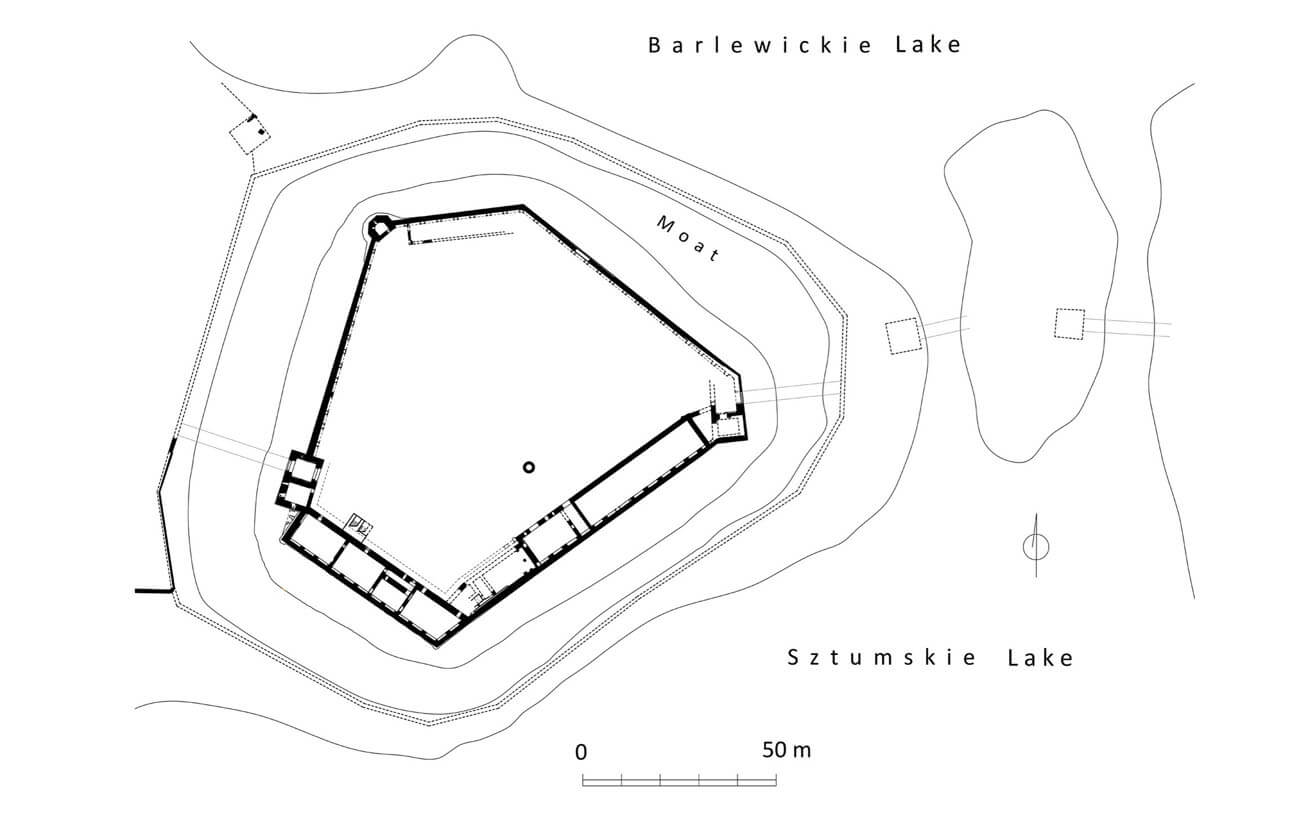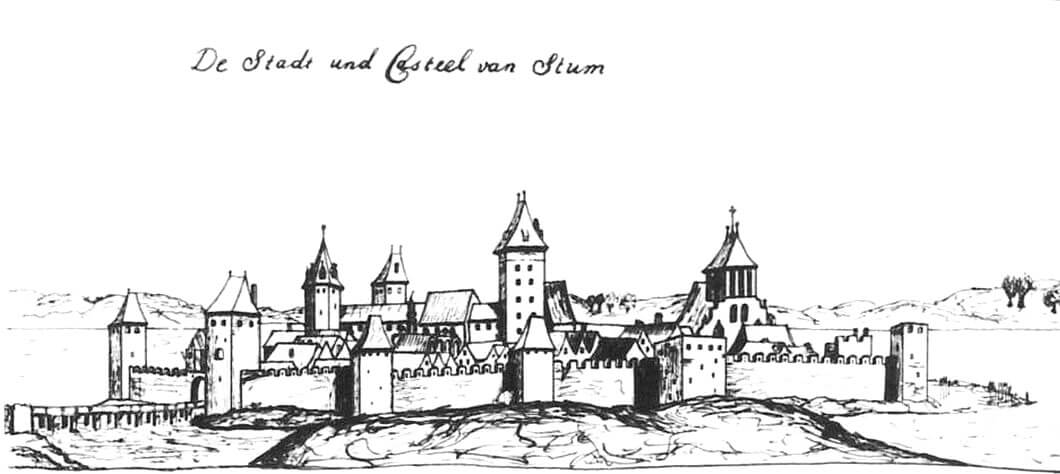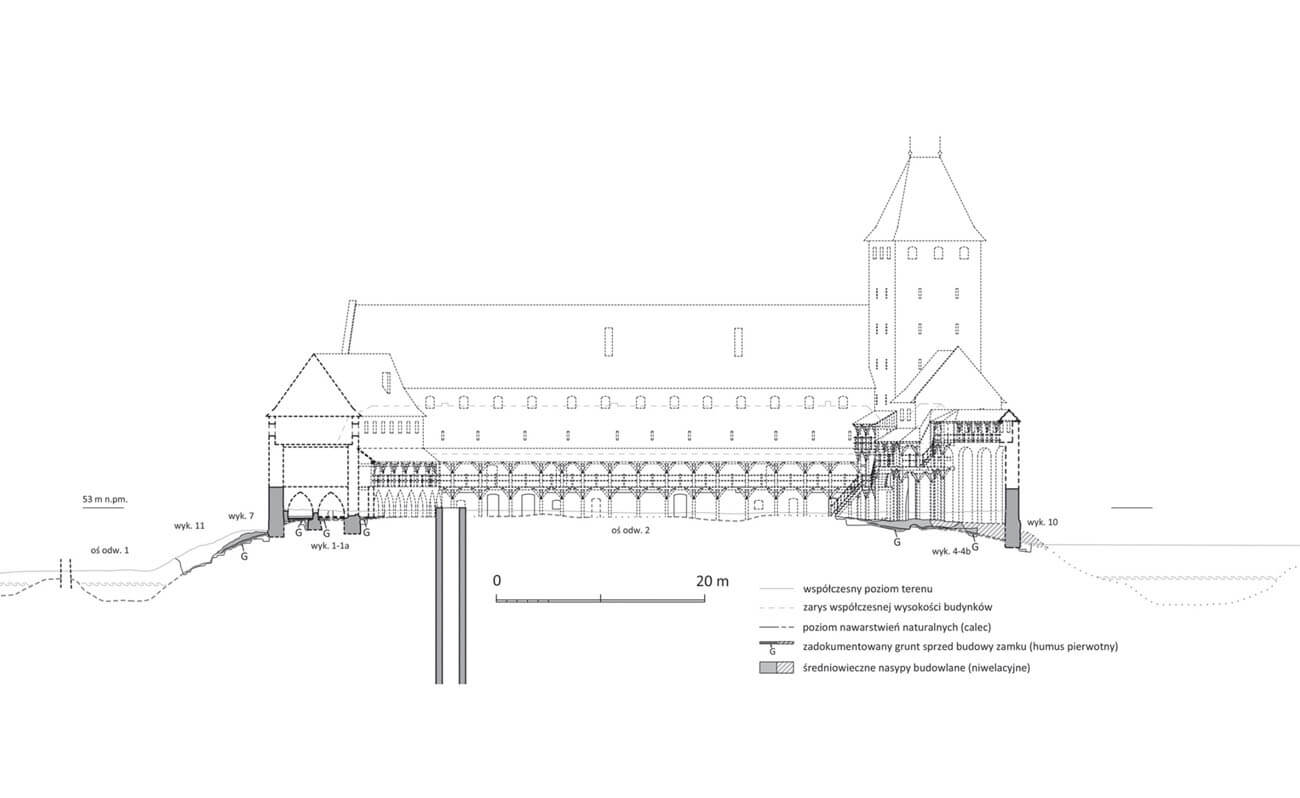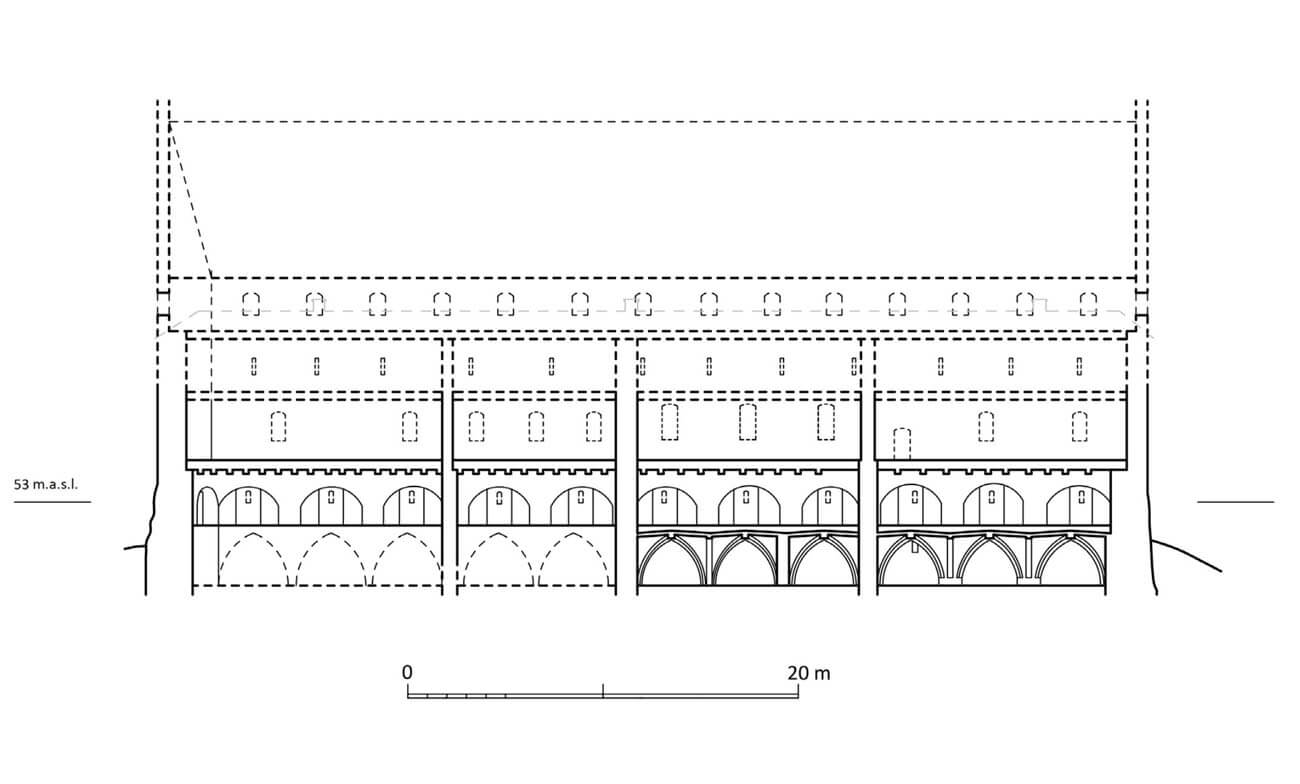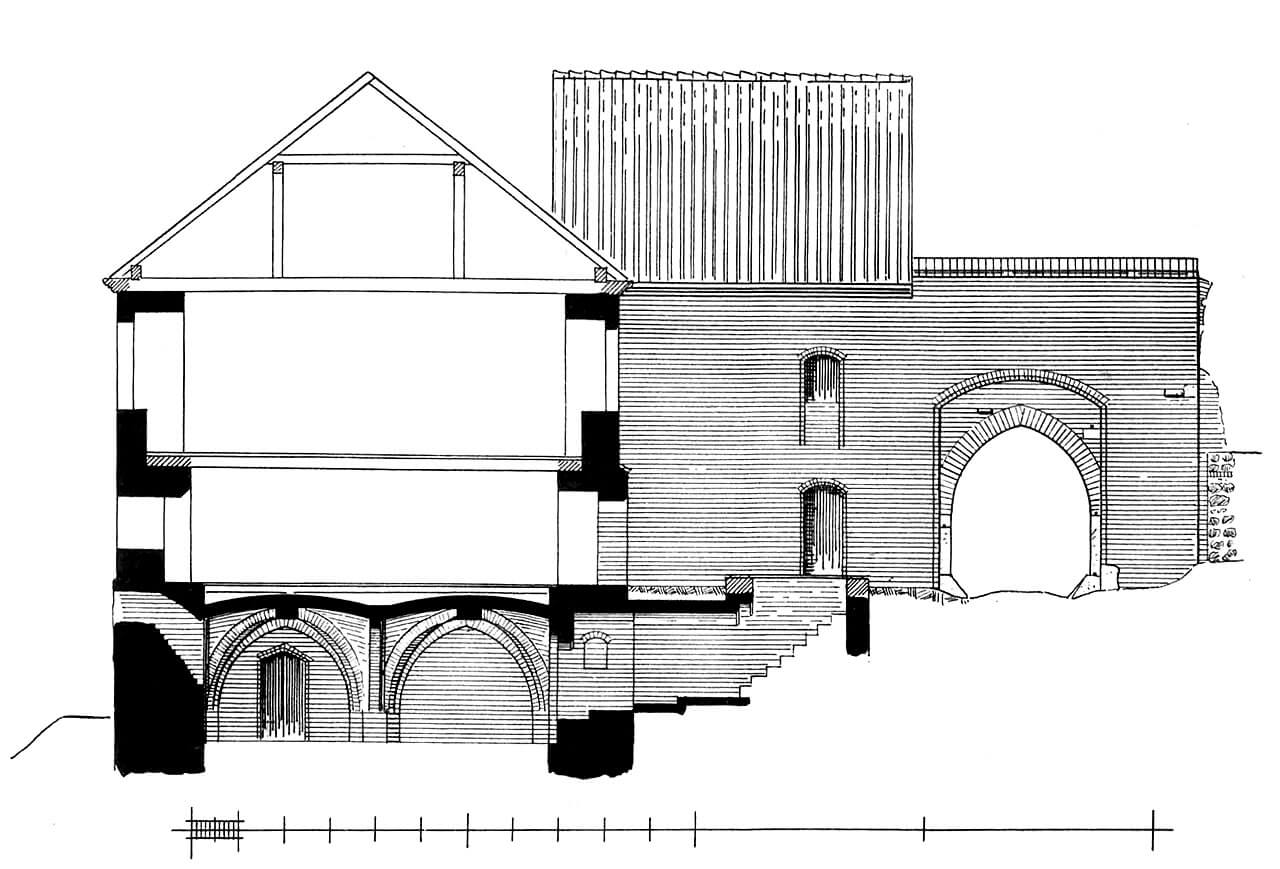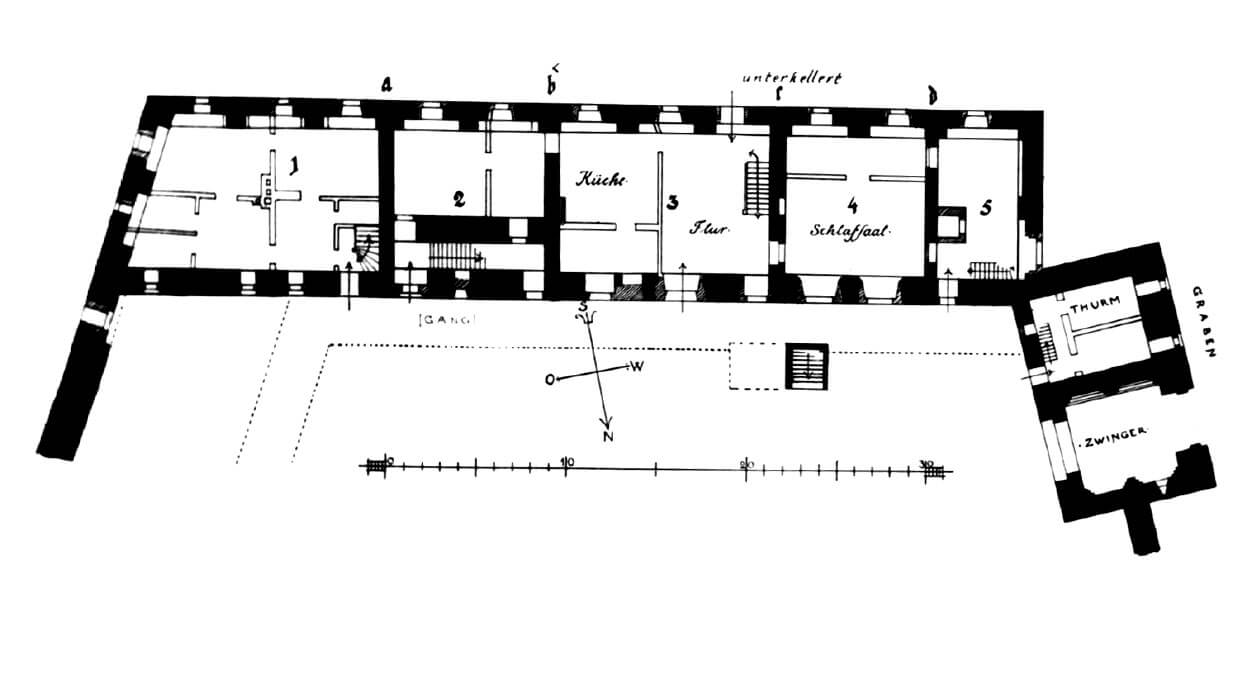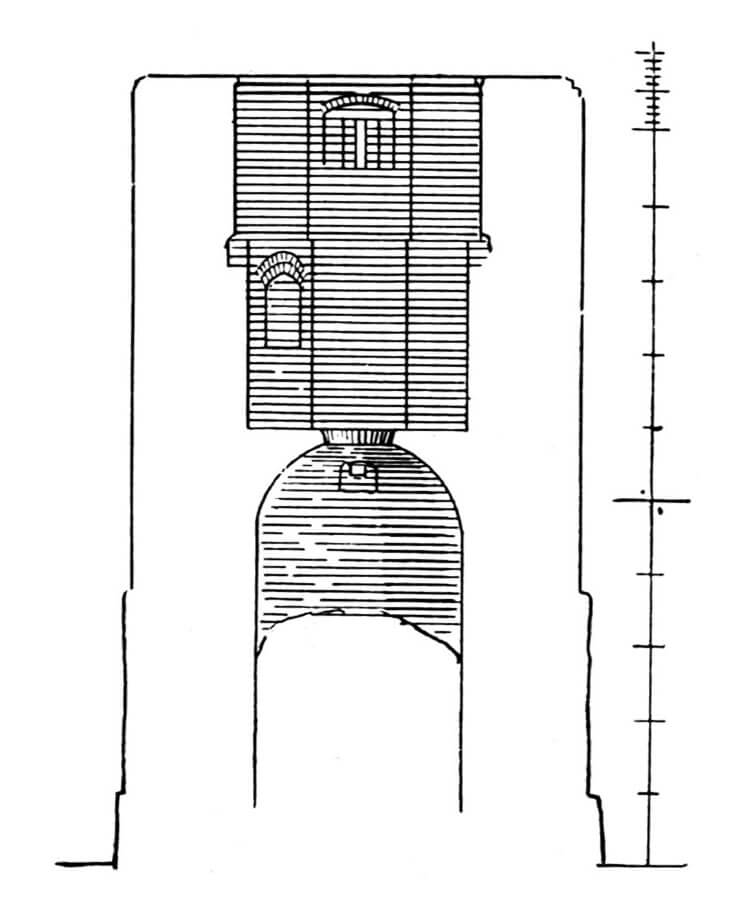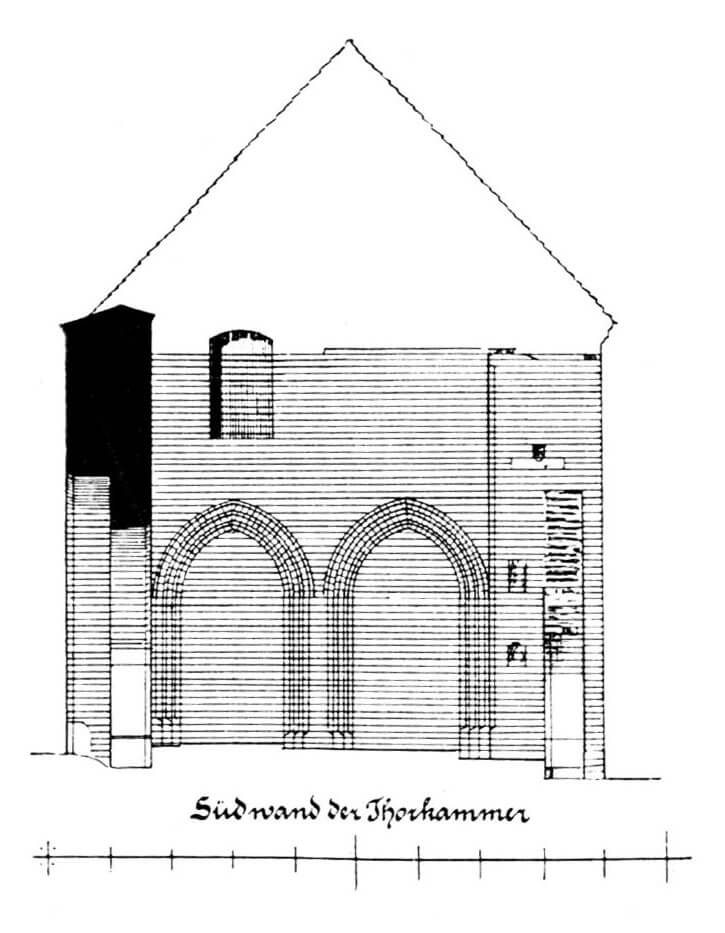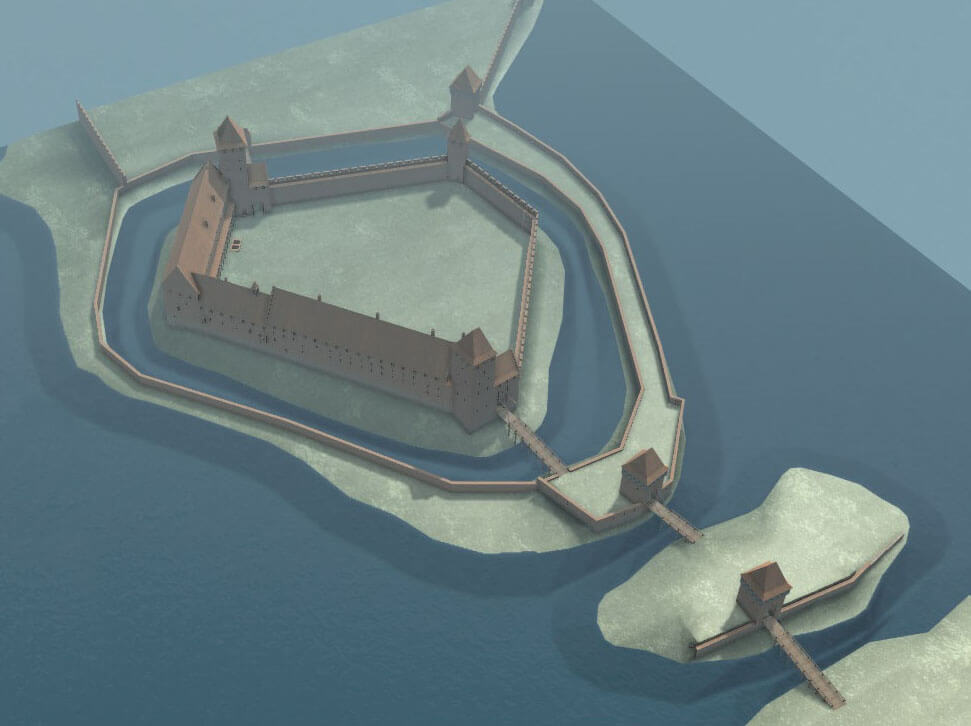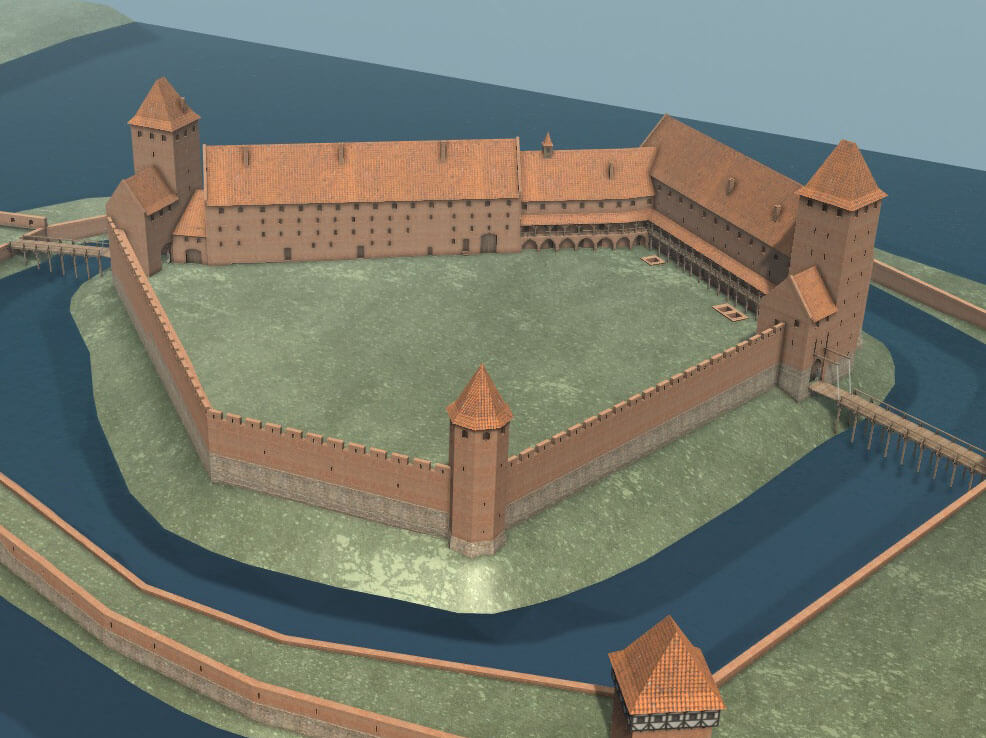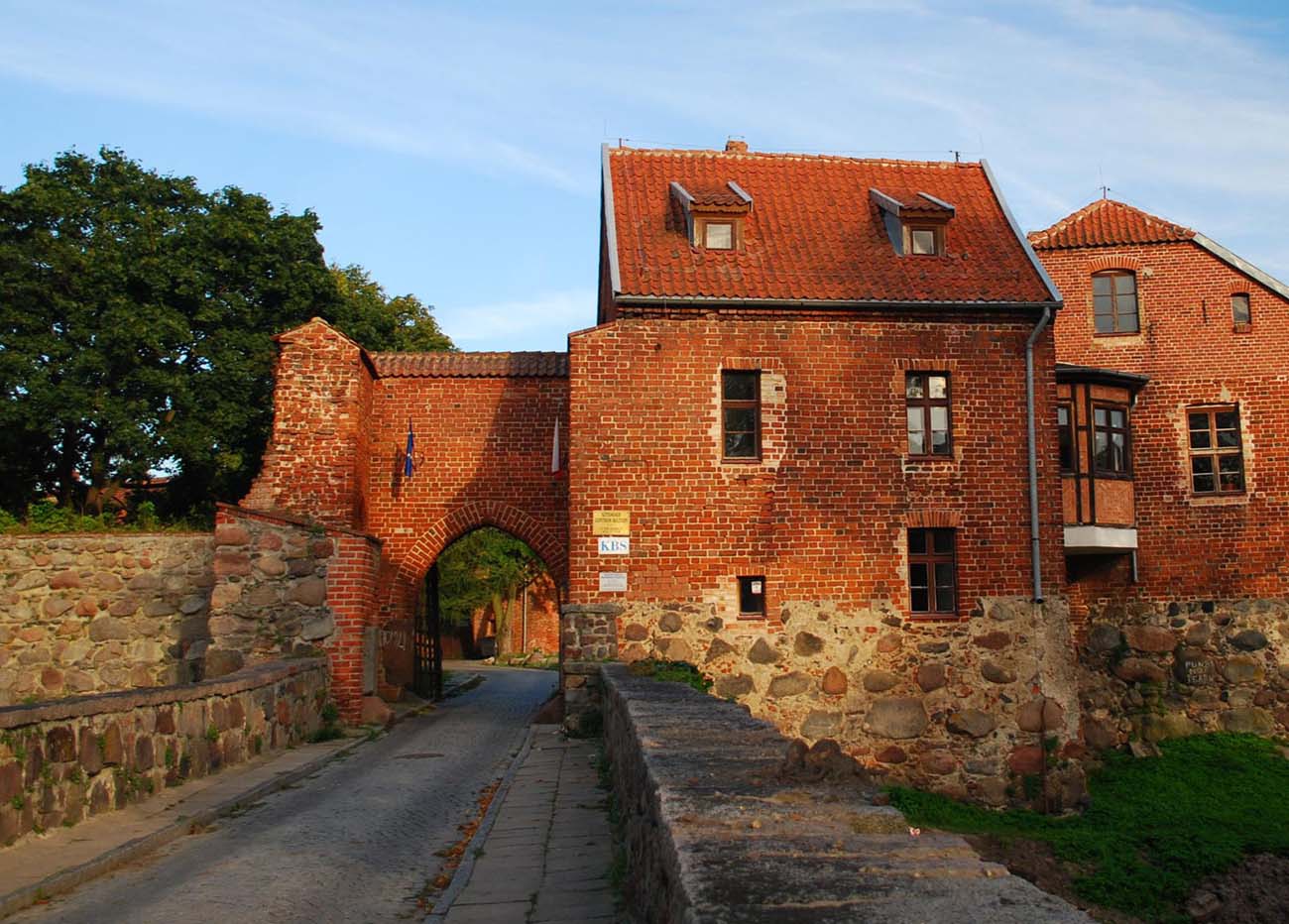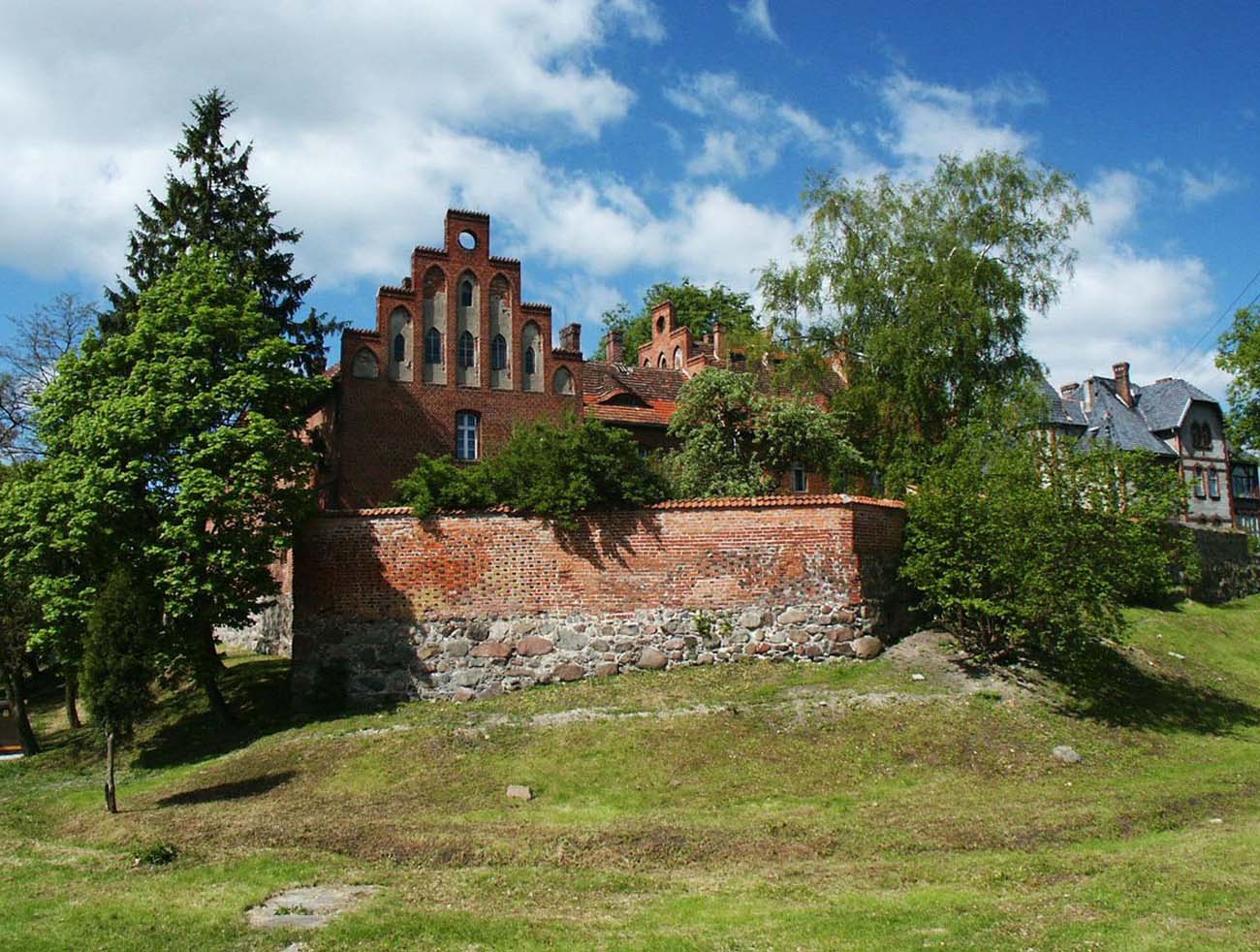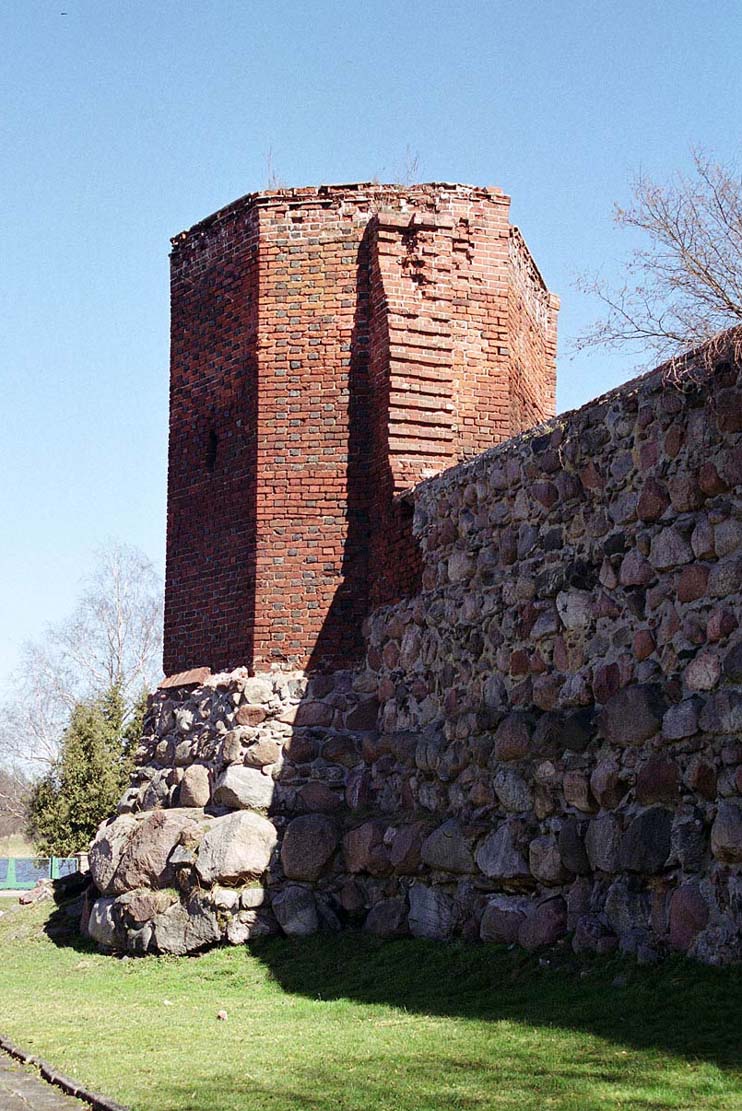History
The grounds on which the castle was later erected were captured by the Teutonic Knights in 1236. Perhaps after the capture of the local Prussian settlement, the knights built a timber watchtower here, because at that time the construction of a brick commandry castle in the nearby Dzierzgoń was in progress, and Zantyr served as a base for further conquests, however, its building has not been confirmed by sources. When the castle was built in Malbork in the fourth quarter of the 13th century, only the Teutonic court existed in Sztum, at which a small settlement was established. It was to be recorded for the first time in sources in 1295 (Stoma farm), and then in 1336 (“Stummis curia nostra”).
A brick castle in Sztum (Stuhm) was built in the second quarter of the 14th century (around 1326), during the time of the Great Master Werner von Orseln or even slightly later around the mid-fourteenth century, despite the fact that from the 1340s Sztum was the seat of the Teutonic vogt, subordinate to commandry in Malbork. Its task was to protect the most convenient route from Germany and Pomerania with the crossing of the Vistula near Zantyr. Important routes crossed in Sztum, including the road to the capital of the Teutonic state, Malbork, bypassing the area of Żuławy and Sztum Forest very difficult for travelers, as well as an important road from Toruń. Therefore, it became one of the best protected strongholds in the Teutonic state, mainly due to the island location, as well as the defense system integrated with the town.
At the beginning of the fifteenth century, castle was expanded, because it also began to act as an occasional residence of Great Masters, using the stronghold during hunting. Guests were often met at the castle, and the proper organization of their stay was one of the forms of diplomatic relations. One of the first was Anna, invited to Sztum in 1399, wife of the Grand Duke of Lithuania, Vytautas, whom the Teutonic Knights wanted to win in order to break up the Polish-Lithuanian union. The duchess visited the castle twice, and in her honor a party was issued for which it was necessary to buy as many as 1290 loaves of bread. Before 1401, for more splendor a zoo was established near the stronghold, to which prince Vytautas gave to Great Master animals from the Lithuanian wilderness. From this period, there are also references to the establishment of vineyards and rose gardens in the vicinity.
The times of hunting and ostentatious feasts passed after the defeat of the Order at the Battle of Grunwald. The vogt of Sztum, Henry Potendorf, fell there, and the castle was captured by bribery and plundered by Polish troops going to Malbork. Władysław Jagiełło entrusted Sztum to the knight Andrzej Brochocki and a selected and well-stocked garrison. Despite this, after the withdrawal of the siege of Malbork and the withdrawal of the main Polish-Lithuanian forces from Prussia, the castle succumbed to the Teutonic forces under the leadership of Henry von Plauen. It happened as a result of the siege started around the beginning of October, as a result of which the main tower and entrance gate burnt, as well as the roof of the southern wing and the castle chapel.
In the second half of the fifteenth century, the burghers of Sztum came to the Prussian Confederation, but after the outbreak of the Thirteen Years’ War in February 1454, the Teutonic Knights defended themselves for quite a long time in the Sztum Castle, until August 8. The reason for the surrender was hunger and illness, as 50 defenders reportedly died of exhaustion. Dilapidated garrison of 70 cavalry and 20 footmen went to Malbork, and the winners garrisoned the stronghold with their own crew under the command of Jan Bażyński, the leader of the Prussian Confederation. After the defeat of the Polish armies at Chojnice on November 18 of the same year, the Teutonic Knights captured the castle and were in its possession until 1466. It was only under the Second Peace of Toruń that Sztum found itself in the lands granted to Poland, and the Polish starosts began to reside in the castle.
In the 16th century, Sztum lost its importance and declined, even the extension of the location privilege in 1553 by king Zygmunt I did not help. The castle was destroyed during the Polish-Swedish war of 1650 – 1655. Although it was partially rebuilt in the following years, it never regained its former glory, and in the 18th century demolition of the weakened walls began. In the 19th century, a court, offices and a prison were located in the castle buildings. In the years 1966-1971, renovation works were undertaken, which were completed only in the 1990s, when the main, southern castle building was repaired.
Architecture
The castle was located in the eastern part of the isthmus, on the island located between two lakes. On its west side was the outer bailey, from which the settlement developed, and next the town, separated by a ditch taking advantage of the natural depression of the terrain. On the eastern side, a bridgehead was created, also separated by a ditch. The whole took a total of about 300 x 800 meters and differed from typical Teutonic defensive complexes. The castle was built on an irregular, trapezoid-like plan, conditioned by shape to the isthmus. Even before commencing the essential construction works, the castle area was raised with a clay surface and the water level in Sztum lakes was regulated, by dredging the natural flow of water integrated into the valleys in the form of a nameless stream flowing from the marshes of the Sztum Forest. The sluice was responsible for water control, mentioned for the first time in 1416, which, if necessary, reduced or increased its level in the moats and in the lakes surrounding the Sztum: Barlewickie and Zajezierskie (Sztum Lake).
All three parts (castle, town and eastern ward – bridgehead) were fortified in the Middle Ages and separated by moats. The town was surrounded by a wall on three sides, and on the fourth, eastern, that is from the castle side was only secured by a moat and its retaining wall. In line of the fortifications, about 10 towers were placed, mainly four-sided, protruding from the face of the wall, initially probably open from the town side. Only two corner towers had a full, closed form. One of the towers flanked the Malbork Gate (placed in a smaller gatehouse) located in the western curtain, while the Kwidzyn Gate was located in the north-eastern corner of the town. It led to the road, which by the northern edge of the island bypassed the castle leading directly to the eastern ward. The latter was probably protected only by earth ramparts in the length of which two gates controlling the entrances on the north-east (Prabuty Gate) and south-west were erected. Most probably each of them was preceded by a drawbridge.
The buildings of the castle were located along the defensive walls surrounding a vast, polygonal courtyard and reinforced with three towers. The lower parts of the curtains, erected in the line of gently slopes, were made of erratic stones, and the upper parts were made of bricks. The walls were topped with a wall-walk, mounted on the inside on brick arcades based on half-pillars. The original height of the curtains, along with the parapet, was about 9.8 meters above the level of the courtyard. Contrary to earlier views, the castle was not surrounded by an external wall forming a zwinger, but only a palisade and the aforementioned moat filled with water, which was separated from the lake by a wall and a narrow strip of land. In cross-section, it was trapezoidal, about 3 meters deep, from the south and west it was about 15 meters wide, while from the south-east it was narrower, about 10 meters wide.
In the south-west part of the perimeter there was a high, four-sided, eight-storey tower, protruding towards the moat in front of the adjacent curtain and flanking the entrance gate. Its dimensions in the plan were 9×9 meters, and the height had to be up to 30 meters, which contrasted with the relatively thin walls, on the ground floor being only 1.7 – 1.8 meters thick. It was connected to the wall-walk in the crown of the walls at the level of the second floor. Inside, in addition to radially arranged arrowslits, it probably housed living quarters (it is known that in 1402 a chimney was repaired in it, so there must have been a fireplace or stove), and there were also in the tower armaments and food warehouses. Although the high silhouette of the tower resembled the old bergfrieds, its military qualities were not too great due to the thin walls. The symbolism of the tower associated with power and ruling, expressed by dominance over the town’s buildings, was probably the decisive role.
In the north-west corner of the castle, a six-sided tower was located, called the Prison Tower due to the pit located in it on the lowest floor (illuminated only by a single ventilation opening). In the early modern period, and perhaps even earlier, this tower was connected with the Kwidzyn Gate by a wooden footbridge. In the upper storeys, arrowslits were created in it, arranged in such a way that they made possible to defend the foreground of the castle, and thus the route running under the tower. In addition, the defense of the castle was provided by a four-sided tower from the north-east (Albrecht’s Tower), flanking a nearby postern or gate. It had dimensions of 7.7 x 8.7 meters in plan with relatively thin walls with living rooms inside. The postern was placed in a four-sided gatehouse adjacent to the tower on the north side, and having the same width.
The main entrance to the castle was placed in the gatehouse in the south-west part of the walls. It was preceded by a timber bridge on the moat separating the castle from the town, raised with iron chains according to the survey. They were attached to a beam placed about 5 meters above the ground, half of which passed through the wall to the inside of the gate, and when lifted, its outer part was hidden in a narrow vertical opening in the wall. In the gate portal embedded in the niche, there were solid and forged oak doors, blocked with horizontal drawbar placed in openings in the wall. The side walls of the gate passage were decorated with pointed blendes with stepped jambs and chamfered corners.
The inner buildings of the castle were placed next to the walls. The main house, on a rectangular plan with dimensions of 11 x 49/52 meters, was located next to the short southern curtain. It housed cellars, ground floor, two residential floors and probably the highest storage and defense storey. There was a refectory, the vogt’s chambers and guest rooms, probably similar to other Teutonic buildings, located on the first floor. Their exact layout is unknown, it is only known that the largest living room was illuminated by two windows and a latrine adjoined it, probably placed in the southern wall. The second floor could be occupied by auxiliary, storage or residential rooms. Later records show that heating was provided by fireplaces and tiled stoves. The ground floor could house utility rooms: a kitchen, pantries, a laundry room, perhaps a bathhouse. Until the construction of the east wing at the beginning of the 15th century, it probably also housed a bakery with a flour and salt warehouse and a brewery. The top storey, intended for a granary, a meat drying room and a farm equipment store, also had economic functions. As in other Teutonic houses, it was surrounded by a defensive porch placed in the crown of the wall under the roof. The cellars were located under the entire building and were topped with rib vaults supported by polygonal, brick pillars. From the side of the courtyard, a brick, two-story cloister was added to the building. The building, like the entire castle, was characterized by stylistic simplicity – no moulded architectural details, only bricks with a straight cut corner were used in the reveals, as well as simple vaults of door openings topped only with segmental arches.
At the south-eastern wall there was a range erected in the first twenty years of the 15th century, housing the summer residence of the Great Masters with the chapel of St. Lawrence. First, a rectangular building was built, 9 meters wide and about 16.5 meters long, which did not reach the southern wing. In the second phase, however, around 1415-1420, the wing was enlarged so that it occupied the entire space of 22-24 meters between the neighboring buildings, with the annex narrowing towards the south-west, because the wall from the side of the courtyard was set at a different angle so that it did not cover the window of the south wing. The chapel was on the first floor and perhaps extended eastwards towards the moat, in front of the perimeter of the main walls. This extended part could also have a defensive function, while the role of a latrine was played by the dansker of Great Masters, known from written records, probably also protruding towards the water. The building basically did not have a basement, but in the southern part it housed a small, barrel-vaulted cellar, 2.4 meters wide, accessible from the south-west through the neck. The ground floor rooms could be of an economic nature, while the first floor, accessible through a brick porch, housed residential chambers. As the building was added secondarily to the defensive wall, it forced the strengthening of the curtain, thickened at least to the level of the ground floor. The building also stood out from the quite austere and devoid of any detail architecture of the castle. It used more sophisticated architecture in the form of moulded fittings or brown glazed tiles.
North of the house of the Great Masters, at the eastern wall, at the beginning of the 15th century, a large building measuring approximately 10.8 x 54.9 meters was erected, still in the Middle Ages extended by the addition of a trapezoidal room at the eastern tower. On the ground floor level, it was divided by brick walls: a bakery, a brewery with a malt house and a large kitchen were in it, while two floors were occupied by a granary. Judging from early modern descriptions, a number of separate entrances to the building led from the side of the courtyard, the rooms could also be internally connected to each other. The building was covered with a gable roof with a gable on the north side.
Next to the walls on the north and north-east sides, more economic buildings were located, mostly built in the half-timber structure (mainly stables). In the Middle Ages, the western part of the castle was the only part free from buildings (the long building by the western curtain was not erected until the second half of the 16th century), which was caused by the desire to leave the most endangered section in front of the town solely for defensive purposes. In the eastern part of the courtyard there was a well. Walled with stone blocks, 30 meters deep, it was said to supply water considered for a long time to be the best in Sztum. The courtyard itself was an exceptionally spacious, flat space surrounded by walls and compact buildings. It met the requirements of a tournament courtyard, as well as a place of banquets, where feasted at portable tables set up in tents or in the open air.
Outside the castle walls, at the outer bailey, and later also within the town there were fishing farms, grange, inn, commercial stalls, garden, apiary, vineyard, zoo and production workshops (brickyard, pottery workshop, lime klin). Further on, water mills and a windmill were within the commandry’s borders.
Current state
Until today the best preserved is south range (the main castle house) with vaulted cellars and ground floor, the perimeter of the defensive walls with a significantly lowered tower at the western gate, a fragment of the western gatehouse and the north-west corner tower. The summer house of the Great Masters was demolished, and the eastern wing was thoroughly rebuilt in the 1820s. The best-preserved part of it today is the southern section, now called the Coach House (two original bricked-up windows, visible from the inside, and the arcades of the curtain wall have been preserved in it). At the castle is the Brotherhood of the Knights of Sztum Land, organized are knights tournaments and battle shows. The castle is open from Monday to Friday in the hours 9.00-16.00 and on Saturdays in the 9.30-12.00.
bibliography:
Garniec M., Garniec-Jackiewicz M., Zamki państwa krzyżackiego w dawnych Prusach, Olsztyn 2006.
Haftka M., Zamki krzyżackie. Dzierźgoń-Przezmark-Sztum, Gdańsk 2010.
Leksykon zamków w Polsce, red. L.Kajzer, Warszawa 2003.
Schmid B., Bau-und Kunstdenkmäler des Kreises Stuhm, Danzig 1909.
Wasik B., The Castle in Sztum in the light of archaeological research in 2019, “Castellologica bohemica”, 20/2023.
Wasik B., Zamek w Sztumie w świetle badań archeologiczno-architektonicznych z 2019 roku, “Pomorania Antiqua”, t. XXIX, Gdańsk 2020.

